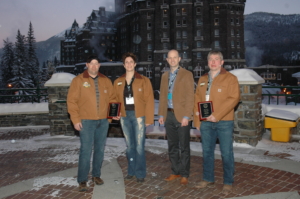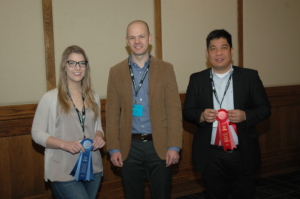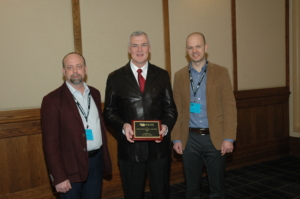“Anything is possible, it just takes longer.” (Author unknown)
The quest to reach beyond what was once impossible continues to spur creative solutions to the business of increasing efficiency in the barn.
Based on the entries for the 2018 F. X. Aherne Prize in Innovative Pork Production, presented during Banff Pork Seminar, the transition from gestation stalls to loose housing has pushed that creativity to new heights.
The prize was awarded to three nominees this year: Lyle and Maaike Campbell, operators of Birnam Pork in Arkona, Ont. and Scott Hyshka,  production manager for Mountain Vista/Sunterra Farms near Drumheller, Alta. were recognized for solutions they had created to resolve issues within their sow rooms.
production manager for Mountain Vista/Sunterra Farms near Drumheller, Alta. were recognized for solutions they had created to resolve issues within their sow rooms.
The Campbell’s came up with an invention they call the ghost gate, which eased some space issues when they expanded their herd.
Breeding crates in the quarantine barn were too large for the gilts, allowing them to flip around and sometimes jostle their AI rods out of place. Using leftover steel stored at the farm, Lyle created a set of portable gates that could be slipped in behind the gilt, holding her steady keeping the rods in place. Maaike Campbell said the gates cost about $50 each and dramatically improved the conception rate in their farrow-to-wean operation.
Hyshka won his jacket for creating a collapsible stall that could be used to isolate individual animals in the gestation room as needed. He manages a 4,300-sow barn that recently transitioned to loose housing and antibiotic free.
Shoulder stalls and competitive feeding were chosen for the barn, creating an issue with inefficiency and aggression within the pens.
The collapsible stall gave his team the ability to pull out sows that were being picked on or that were too aggressive during their introduction to the group. Those animals are kept in the isolation stall to allow them to recover and adapt, reducing pregnancy losses and other issues that affect productivity.
Hyshka said the crates were made collapsible to save space in the pens, which hold 10 to 15 sows each. “This award . . . was created in recognition of Frank Aherne, who was a professor in swine nutrition and production at the University of Alberta,” said session emcee Ben Willing, a professor in the University of Alberta swine program.
The award was created upon the passing late in 2005 of Prof. Aherne, who drove his students and colleagues to continually seek new and better ways to help producers improve their bottom lines.
A second award program which honours graduate students for their research was recently renamed in honour of one of Aherne’s former colleagues, U of A nutritionist Ron Ball.
 The R. O. Ball Young Scientists competition recognizes the work of graduate students conducting swine research with prizes of $250 for second place and $500 for first place. The four finalists for 2018 were named after a poster competition outlining their research and results.
The R. O. Ball Young Scientists competition recognizes the work of graduate students conducting swine research with prizes of $250 for second place and $500 for first place. The four finalists for 2018 were named after a poster competition outlining their research and results.
Final judging was based on presentations the four finalists made during the afternoon breakout session on the first day of the seminar and presented the following morning.
Second prize was awarded to Jill Hugman, a post-grad student working with Prof. Ruurd Zijlstra at the U of A.
Hugman worked on a project analyzing field peas as a dietary alternative for weaned pigs. Her group determined that steam-pelleted off-grade field peas could replace a portion of the weaned pig diet without affecting growth performance.
First prize was awarded to Danilo Sotto, a post-grad student at the University of Saskatchewan, for his work on a project designed to determine whether farmers could use low-quality grain in a weanling diet. “Our project is mainly on (how) acidified, high-moisture grains are comparable when you give acidified diets to pigs. We did not know whether acidified barley would give the same benefits to pigs as direct acidification of the diet,” Sotto said in an interview.
Their findings show farmers how high-moisture, low-quality grain can be used in a weanling diet, saving cost to the producer without affecting the pigs. It is assumed that this project would be most relevant to hog producers who are growing their own crops, said Sotto.
Willing said during presentation of the awards that all four finalists were worthy of the prize and that, in a different year, any one of them could have earned first place.
Left out of the money were Huaigang Lei from the U of A for his work on flavour and texture as related to intramuscular fat and Austin Putz from Iowa State University who investigated heritable disease resistance as a means of selecting for lower levels of treatment and mortality losses.
The third award category presented during seminar was The George Foxcroft Lectureship award. Three speakers featured at a breakout session the  day prior, emphasizing there are few things more basic to pork production success than sow lifetime productivity, each with compelling information on key aspects of this management area .
day prior, emphasizing there are few things more basic to pork production success than sow lifetime productivity, each with compelling information on key aspects of this management area .
This years winner was Dr. Mark Wilson of Zinpro. Wilson’s presentation was entitled “The impacts of lameness, longevity and inflammation on productivity and management of the sow herd.” •
— By Brenda Kossowan




